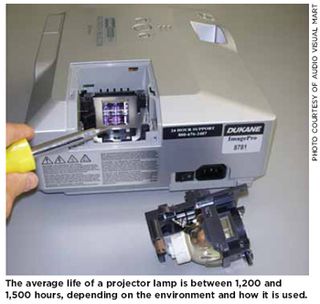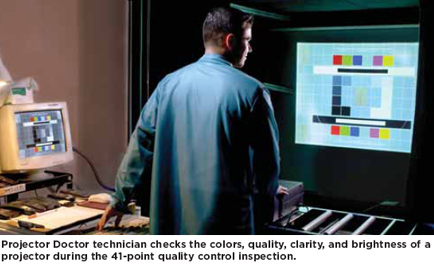Business leaders, school instructors, and field trainers who rely on projectors to execute lesson plans and training have come to expect seamless projector operation in the field, corporate office, and classroom. But when a lamp dies and the projector fails, the dream of a flawless presentation quickly comes to an end. It could take several minutes, hours, or even weeks for the projector to be fully functional.
- Preventive projector maintenance often plays a hand in averting lamp failure, and AV companies providing programs to service projectors on a yearly, semi-annual, quarterly, or monthly basis help eliminate unexpected breakdowns. But is this service right for you? In many cases, the environment, knowledge of the staff, and available time all take part in determining
- the need for an outsourced preventive maintenance program.
FACTORS CAUSING FAILURE
According to Chris Frederick, help desk manager for Sensory Technologies, Indianapolis, IN, the average life of a typical projector lamp is between 1,200 and 1,500 hours with the environment and usage presenting the biggest variables. "For instance, if
you have a projector in a bar or smoky location, the projector is going to get less good, clean air filtered through it," he says. "It's going to run hotter, and, in turn, the lamp won't last as long." In a classroom environment, chalk dust circulating through the air also will be picked up in the projector, creating a similar situation.
Another factor affecting lamp life is how long it is being used. Is the projector on for an hour and then turned off, receiving adequate time to cool down, or is it running 24 hours a day with no chance to cool off? "The hotter the projector runs, the less life you are going to have on your projector lamp," Frederick says. "It's like your car. If you keep friction down, you're going to get more life out of your components."
Even turning off the projector can impinge on lamp life. Odilia McLeod, director of sales and marketing for Projector Doctor, Poway, CA, says users not well-versed in audiovisual equipment will often turn off the projector instead of powering it down, which can significantly shorten the lamp life. "It's important that they power it down and allow the fans to run and cool down the lamp," she says. "Every component on the board that does not cool properly will fail eventually."
In environments where the projector is running all day every day, McLeod says the projector should be powered down at least once during this time period. This allows for the unit to cool off, plus any carbon build-up inside the bulb will burn off when the lamp is ignited. It also will help extend the life of the lamp, she says.
Without a regular cleaning, a projector's life has limits. For example, dust in the air can become magnified, attaching to the LCD panels and causing burn spots in the panels, says Bob Normandin, owner of Carolina Projector Solutions, Raleigh, NC. "If you burn one of the panels on a $2,000 projector, it's going to cost $1,500 to replace the panel," he adds.
Roy Sartipi, CEO of LCD Presentation Systems, Poway, CA, says he has seen cases where dirty filters have caused the machine to overheat and damage the LCD panels and optics. "They have more cost in the long run than they would if they had regular maintenance," he says.
AN ARRAY OF SERVICES OFFERED
Preventive maintenance programs vary by the provider and location. Carolina Projector Solutions requires projectors to be sent to its office in Raleigh, where the lenses are cleaned, the optics are cleaned and aligned, and lamp life is checked. The highand low-voltage power supplies are also checked to make sure they are putting out the right amount of power. "When a projector leaves here, it is in the best shape it can be in without making any replacements," Normandin says.
Projector Doctor and other service providers offer similar preventive maintenance programs, which include cleaning and aligning the optics and LCD panels; cleaning or replacing the air filter; and multi-point inspections that include verifying color quality, testing inputs, checking keypad functionality, and testing the focus and zoom functions of the lens. "For our clients that have our 'platinum' service, we change and clean the filters on a quarterly basis at their location," says Bruce Payton, general manager of Audio Visual Mart Inc., Kenner, LA. "Others send in the projector once a year to be cleaned, we have them clean the filter every quarter, and we look at lamp life twice a year."

Sensory Technologies reports it offers various levels of preventive maintenance. "On our most basic, we would come out to the client's site and do a full system check, and make sure everything is working as it should," Frederick says. "We clean the filters and check lamp life. If the lamps need to be changed, then we change it." Expanded preventive maintenance packages entail software upgrades to ensure the projectors are compatible with other devices on the network.
The cost for servicing a single projector ranges from $125 to $199. For many companies, this price does not include the service call, shipping, projectors that weigh more than 45 pounds, or machines that require extra cleaning, such as those from clubs that are caked with nicotine or residue from fog machines. Carolina Projector Solutions, Projector Doctor, AVMart, Sensory Technologies, and LCD Presentation Systems all report they provide a discount per projector for customers with multiple units.
"If a customer has a service contract or platinum service, we go out and do the work on-site at no charge," Payton says. "If a client wants on-site service but does not have a contract, then we go out and charge for the service call plus parts. All others must bring the projector in for service unless, of course, the unit's under warranty. In this case, we go on-site to troubleshoot the problem at no charge."
Sartipi says LCD Presentation Systems' preventive maintenance costs include traveling to the customer's site as long as it is in San Diego County. Additional travel charges apply if the job is outside the area. "When we take a maintenance job, we try to convince the customer to cover the full system, including the projector, sound, amplifiers, DVD and visual sources, the controller systems, and whatever that is in that room and connected to the projector," he says. "In many cases, the projector's problem can very well be an issue with the source, and if it is not in our agreement, then we would have to go back and forth, trying to have whoever is in charge to take care of the problem before we can get the projector up and running."
The amount of time between servicing also depends on environment and usage. Sensory Technologies' standard preventive maintenance is once a year, but it has clients with heavy projector usage that require cleanings more than a couple times a year.
For projectors that are used on an average of six hours more a day, such as in classrooms, theaters, restaurants, and high-use conference rooms, Normandin says they should be disassembled and cleaned by an experienced technician at least two or three times a year. He adds that the air filters should be cleaned or replaced every 100 hours of use, according to the manufacturer's specifications.
Projectors that use DLP technology, which have high-speed color wheels that dirt has a hard time attaching to, should be disassembled and cleaned at least once a year, Normandin says. "If it's an LCD-type machine, you need to do it twice a year," he adds.
McLeod also suggests that preventive maintenance once a year is enough for a conference room environment. "If you're in an area with a lot of construction or the projectors are exposed to the outside, I would say twice a year," she says. "If you have it in a club, then you probably want to do it quarterly."
SEND IT OUT OR KEEP IT IN-HOUSE?
Corporations and schools with a large number of projectors face the reality that preventing projector failure can create quite a demand on its technical staff. "With 30 to 50 projectors per school, the process takes a considerable amount of time for a one- or two-person IT department to physically check all the projectors," Payton says. "It would take a week for an IT person to check each lamp."
Not only is it physically demanding, but the in-house technical staff may not be trained to maintain a projector, aside from changing the lamp or cleaning the filter. "You don't know how much knowledge the person has with projectors," Sartipi says. "It's like having someone who doesn't know about cars try to change the filters and do an oil change. They can definitely damage it." When an untrained person opens up the projector, he or she can throw off the convergence, scratch the lenses, cut the cables, or misalign the lenses, which can cost anywhere from a few hundred dollars to a few thousand to fix, he adds.
McLeod says if a person who is not authorized to work on a projector opens it up, it will void the warranty. "If they have their own technicians, they need to clear it through the manufacturer," she says.
Many companies offering preventive maintenance require its technical staff to be trained and certified. Sensory Technologies uses InfoComm CTS certification among others to make sure its technicians are up to speed on all practices used by AV integrators. "A lot of the manufacturers require us to maintain these certifications to sell and service their product," says Kevin Markey, company principle. "You can't get those by being a user. You have to be an authorized dealer that represents the manufacturer, so it's not necessarily available to your standard internal organization AV or IT person."
At less than $200 a cleaning per projector, outsourcing preventive maintenance is a small price to pay to get the most out of a projector, but there is a breakeven point for some companies. "It's the cost of replacement vs. maintenance," McLeod says. "If you want your projectors to last a certain number of years, then preventive maintenance will ensure that time frame is kept to, rather than having to send the projectors out for repair or replace them faster. It's more of a budget decision."
Katie Parrish is a technical writer based in Independence, MO. She can be reached at kateparrish@ comcast.net.










